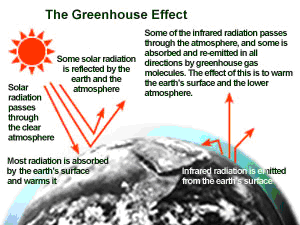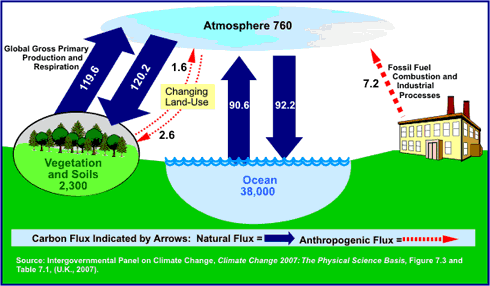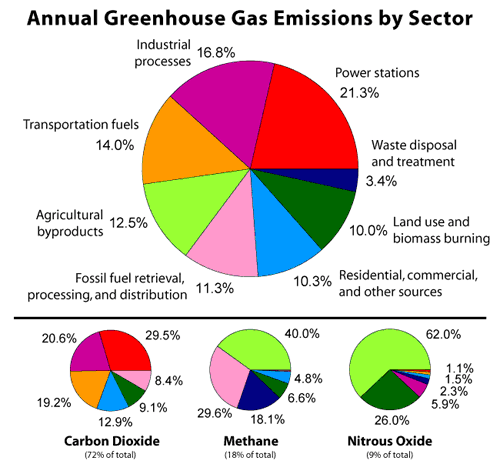Global warming: does it really exist?
INTRODUCTION
Global warming in the last few years has become great environmental challenge to many people and a very important issue that needs to be addressed by nations. It is a topic that has sparked global attention and information about its causes will be briefly explained in this article. Reports from the Intergovernmental Panel for Climate Change (IPCC) and evidence from scientists are proving that most observed temperature increases for 50 years were caused by increases in concentration of greenhouse gases due to anthropogenic/human-related activities such as burning of fossil fuels which includes oil, gas and coal, burning of forests, widespread deforestation, and mining, agriculture, etc. Some of this activity has contributed to the majority of greenhouse gas emissions to the Earth’s atmosphere. Earth’s atmosphere is made up of heat-absorbing component gases which protects the Earth and keeps atmospheric temperatures comfortable to support life.
2.0 Technical Review
2.1 What is Global Warming?
Imbalances in the composition of the atmosphere due to emission of greenhouse gases poses a threat to the Earth by intensifying the warming effect and heating of the atmosphere. The increase or rise in the average temperature which gradually warms the Earth’s atmosphere is therefore referred to as global warming. Other phenomena, like solar variations and volcanic eruptions, are also responsible for global warming. According to IPCC, studies have shown that the Earth’s atmospheric temperature has risen from 0.18–0.74 degrees and scientists estimate a global temperature rise of between 1.5–4.0 degrees Celsius (Houghton et al., 1996) in centuries to come.
Note: Not all climate changes may have adverse effects.
The warming effect of greenhouse gases was first discovered in 1827 by French scientist Jean-Baptiste Fourier, whose works led to the name ‘greenhouse effect’. The science of the greenhouse effect was quantitatively investigated by Swedish chemist Svante Arrhenius in 1896, who calculated effects of concentration increase in gases. Some observatory works of other scientists, such as Roger Revelle and Hans Suess in 1957, gave the first expressional concern about climate change.
Simply put, global warming is the consequences that result from the greenhouse effect. The Earth’s atmosphere is made of various gases of which nitrogen and oxygen make up the bulk of the air. The rest in the composition of atmosphere, like carbon dioxide, water vapour, methane and other present in small quantities, absorbs or emits thermal radiation thus warming the Earth’s lower atmosphere and surface. These gases act like a partial blanket for this radiation and this process of blanketing is known as natural greenhouse effects (Houghton, 2009). The atmospheric gases involved are known as greenhouse gases.
Natural greenhouse effects involves all atmospheric gases present long before the advent of activities of human beings, while enhanced greenhouse effects refers to effects of additional gases in the atmosphere due to human-related activities. In this effect around the Earth, the atmosphere may be seen as a ‘blanket’ made thicker because of the composition of gases. The level of these greenhouse gases, especially carbon dioxide, has substantially increased in this era of industrialization according to researchers.

Source: US Environmental Protection Agency 2007 (8)
2.3 Major Causes and Effects
Increased concentration through various greenhouse gaseous emissions are the major causes of global warming. Greenhouse gaseous emissions are influenced by both human-related activities and some few natural causes, such as volcanic eruptions. The atmospheric concentration, strength and rate of absorption of infrared radiation vary dramatically among gases. Based on this parameter, the most dominant greenhouse gaseous emissions are carbon dioxide, methane, water vapour, nitrous oxide, chlorofluorocarbons, ozone and others.
2.4 Global Warming and Carbon Emissions
Carbon emission is the release of carbon and other related substances to the atmosphere through natural activities, and accordingly through anthropogenic/human-related causes. The most dominant of all carbon emissions is carbon dioxide and its level including several other greenhouse gases has increased dramatically since the beginning of the industrial revolution in the last 150 years.
Within the last 20 years, the atmospheric concentration of carbon emission has risen to about 31% greater than over pre-industrial times (IPCC, 1998). This concentration is regulated by a natural process which controls the movement of atmospheric carbon through the Earth’s surface known as the CARBON CYCLE (see fig. 2). The processes include respiration needed to maintain our life and decomposition of organic materials both contributing to atmospheric carbon dioxide, and plant photosynthesis which offsets the processes of respiration and decomposition by making use of the carbon dioxide, thus returning oxygen back to the atmosphere in order to create a balance.

Figure 2: Global Carbon Cycle between various reservoirs (Billion Metric Tons Carbon)
Carbon dioxide is not destroyed but redistributed among carbon reservoirs through the processes as described in figure 2, which enables the atmospheric carbon concentration to be remarkably constant. For thousands of years, a steady balance was maintained before the advent of industrialization, but activities from different sectors dependent on fossil fuel combustions has led to a rapid increase in concentration of carbon and other greenhouse gases in the atmosphere (see fig. 3). Consequently, as our technological ability increased, so did our potential for altering the environment in which we live (Drake, 2000).

Figure 3 Source: US Environmental Protection Agency, 2000. (9)
This change in the environment is due to atmospheric increases in concentration of carbon dioxide by about 36%, from 280 ppm around 1700 to a value of over 380 ppm at the present day (Houghton, 2009). Dependence of various sectors in the burning of fossil fuels for energy have increased dramatically since the industrial revolution and, during the ’90s, emissions rose 0.7% per year; from 1999 to 2005 annual emissions rose systematically (Houghton, 2009), and almost all were released to the atmosphere as carbon dioxide. Another contribution to atmospheric carbon dioxide due to anthropogenic activities result from land use change, which is mostly from tropical deforestation balanced partly by afforestation. Their contributions were estimated in figure 2. For 2007 (see fig. 2), annual anthropogenic emissions from fossil fuels combustion, industrial processes (about 3% of the total) and land use change amounted to 8.8 billion metric tons; approximately 79% of these resulted from fossil fuel burning. Since the annual net increase in the atmosphere was 3.3 billion metric tons, about 37.5% of the 8.8 billion metric tons of new carbon remained to increase the atmospheric concentration. The other 62.5% was taken up by the ocean and land biota. As the global average temperature increases, the fraction of carbon dioxide taken up by both the land and ocean are likely to reduce (Houghton, 2009).
2.5 Non-Carbon Dioxide Greenhouse Gaseous Emissions
These are greenhouse gaseous emissions other than carbon dioxide. The gases associated with these emissions are usually more potent in causing greenhouse effects than carbon dioxide emissions, thus playing an important role in global warming. This is mostly due to their ability to remain in the atmosphere for a longer period of time than carbon dioxide. Examples are:
Methane
It is regarded as the most dominant non-CO2 greenhouse gaseous emission, and plays a very critical role in global warming. Data of ice cores have shown that the concentration of methane in the atmosphere have more than doubled from 700 ppb in the 1800s to a value that is presently alarming, about 10 ppb per year increase (Houghton, 2009). Generally, the atmospheric concentration of methane is less than that of carbon dioxide (see fig. 3), with its greenhouse effect about 20 times more than carbon dioxide emission. They are more powerful in causing global warming than carbon dioxide with its approximate chemical lifetime being 12 years, comparatively with 100 years of carbon dioxide (US EPA, 2006). Accordingly, the percentage of annual total global emissions for methane is 18%, carbon dioxide 72%, Nitrous oxide 9%, with high global warming potential gases (high GWP) occupying the remaining 1%. Compare to carbon dioxide, methane. Their prominent sources are mostly natural sources from wetlands with estimate range of values 90–240 million tons per year, termites 10–50 mt/yr, ocean 5–50 mt/yr, with others closely associated with anthropogenic/human activities such as coal mining, natural gas and petroleum industries 75–110 mt/yr, enteric fermentation 70–115 mt/yr, waste treatment, biomass burning, landfills and sinks etc (Houghton, 2009).
Note: Sinks refers to a variety of processes for removal of methane from the atmosphere and is also made up of soil removals and atmospheric increase.
Nitrous Oxide
It has powerful greenhouse effects more than CO2, with an atmospheric lifetime of about 120 years. Since the pre-industrial times to 1998, the global concentration of nitrous oxide in the atmosphere has risen from 270 ppb to about 314 ppb, translating to an increase of about 16%, steadily increasing at the rate of 0.25% per year in the last 20 years (US EPA, 2006). The natural source of largest emissions of nitrous oxide is usually associated with a variety of biological sources from water, soil and general natural and agricultural eco-systems. The human activities linked are agric. soil management in some cases due to increases in fertilizer, animal waste management, fossil fuel and biomass combustions and industrial sources from production of nitric acid, nylon etc.
Chlorofluorocarbons (CFCs) and Ozone
They are man-made chemicals consisting of carbon, fluorine and chlorine. Out of many, three main kinds exist, namely, CFC 11, CFC 12 and CFC 113. Because of their non-flammable and non-toxic nature, they serve as a refrigerant and a propellant. They are chemically unreactive, with atmospheric time length of about 100–200 years, also with atmospheric concentration of about 1 ppb (Houghton, 2009). They are known to be very powerful in causing environmental damage, such as ozone depletion. Because of these known consequences, concentration is no longer growing due to international action taken by the Montreal Protocol and other more recent amendments in London and Copenhagen. The compound ozone, when present in very high concentration, can also cause environmental and health problems. Among other sources, ozone is generated from nitrogen oxide emissions from aircraft.
Higher Global Warming Potential Gases
These gases include major groups of hydrofluorocarbons (HFCs), perfluorocarbons (PFCs) and sulphur hexafluoride (SF6).They have a shorter atmospheric time length as in HFCs and are less ozone destructive than CFCs. PFCs and SF6 have a higher atmospheric time, meaning they can stay in the atmosphere for a very long time for over a thousand years. The value of their GWP ranges from 140–11700 for HFCs, 5000–12000 for PFCs and 23900 for SF6 (US EPA, 2006).
Indirect Greenhouse Effect Gases
These gases such as carbon monoxide, SO2 and nitrogen oxides have an influence in global warming mostly by their reaction with primary greenhouse gases. These gases, as emitted from vehicles and aircraft, chemically react with GHGs thus having a combined effect on global warming adding to the major contributors like CO2 and CH4. Their direct contributions including water vapour and aerosols might be comparatively less than others, but still worth taking into account.
3.0 Discussion
Global warming is presently a huge debate with many sceptics about its true existence. Most sceptics believe this could be a political tool by developed economies to benefit through heavy taxations on major world industries and trade companies. In these current scenarios, so many questions are raised. What is the reality of global warming? Is it really caused by human activities? These are complex questions that need to be answered to enable us to draw a valid conclusion.
From evidence gathered and observation of the climate in the last 50 years by researchers, scientists and IPCC, there is strong evidence of global warming in the last 50 years. Extreme summer/weather temperature due to climatic change is one of the facts that prove its reality. In the tropical regions, e.g., the West African region, it is a known fact that the climatic temperature is becoming more and more unbearable as each year passes, unlike past years. These temperature rises have also led to the destruction of the eco-system, terrestrial and marine habitats. The same may be applied to temperate regions like the UK, where the summers are lasting longer than usual and becoming more intense as the years roll by. Further evidence is the changes in rainfall pattern. Within these years, more water shortages and natural disasters, such as increased frequency of hurricanes and intense storms, have been experienced than ever recorded.
Other effects on climatic conditions have led to degradation of soil, affecting agriculture, marine and global food supply.
The accelerated melting of polar ice sheets and glaciers in the last 20 years, disintegration of sea ice, as evident from ice measurements and use of arrays of satellite, cooling of the Antarctica and warming of the Arctic region are further proof of the existence of global warming. In the last 50 years, we have experienced a rise in sea levels currently measured by scientists.
Acidity of oceans due to the absorption of carbon dioxide and other non-carbon dioxide gases has damaged marine species with further effects on secondary food chains. All this evidence, among others, as provided by researchers and scientists has gone a long way to prove that the planet is indeed warming up and some threats of global warming actually exist, though the effects might prove costly to some regions more than the others.
Argument Arising
The fact that global warming exists need not be overemphasized. The greenhouse gases as discussed above have been proven to play an important role in the warming of the planet. There seems to be so much blame on carbon dioxide emissions as the sole cause of global warming, with other gases like methane, nitrous oxide and other high-GWP gases usually underestimated. Yes, it could be argued that carbon dioxide emissions are the most dominant, but methane emissions and other non-carbon dioxide emissions have been found to be more potent and powerful in causing global warming than carbon dioxide due to their ability to stay in the atmosphere for years when emitted.
Some basic arguments have been raised about linking sources of global warming to human activities. It is worthy of note that there is no established general consensus on a direct link between humans and global warming. There is a strong possibility of a connection of global warming to natural cycles with the general belief on human causes being presently over exaggerated. Though there is growing evidence on global warming being the cause of heavy rainfalls, hurricanes and storms, the connection between these disasters and global warming, from greenhouse gaseous emissions, have not been truly established. Another argument is the sole emphasis on anthropogenic sources of global warming without taking any account of effects from solar radiation, which normally is known to cause an appreciable percentage of global warming.
Addressing the above complex questions and arguments is a difficult task that at most will enable us to achieve a valid conclusion about global warming.
4.0 Conclusion
The conclusion is as follows:
- Global warming is real and truly exists.
- Both carbon dioxide greenhouse gaseous emissions and non-carbon dioxide gaseous emissions, such as methane, nitrous oxide and others as discussed above, play important roles in the global warming processes.
- Non-CO2 emissions are more potent to global warming than CO2.
- Evidence and observations from researchers and scientists have gone a long way to prove the effects of global warming.
- Various arguments have risen during discussions about issues concerning global warming, as discussed in the concluding part of the discussion chapter.
- Addressing those arguments will provide a valid conclusion.
5.0 References
Houghton, J., 2009. Global Warming: The Complete Briefing. Pg 1– 92, 172-233, 260-322
United States Environmental Protection Agency, 2006. Global Mitigation of Non-CO2 Greenhouse Gases. Retrieved November 22, 2009 from http://www.epa.gov/climatechange/economics/downloads/GlobalMitigationFullReport.pdf
Braash, G., 2009. A World View on Global Warming. Retrieved 22, 2009 from
http://www.worldviewofglobalwarming.org/pages/aboutwarm.html
Mohr, N., 2005. Earth save International Report: A New Global Warming Strategy. Retrieved November 22, 2009 from http://www.earthsave.org/news/earthsave_global_warming_report.pdf
Intergovernmental Panel on Climate Change, 2007. Retrieved November 22, 2009 from
http://www.solcomhouse.com/greenhousegases.htm
Drakes, F., 2000. Global Warming: The science of climate change.
Vardiman, Larry, 2007. Evidence of Global Warming: Acts and Facts Retrieved December 6, 2009 from http://www.icr.org/article/3233/
United States Environmental Protection Agency, 2009. Climate Change- Science. Retrieved November 22, 2009 from http://www.epa.gov/climatechange/science/index.html#ref
Globalwarming.org.in 2009. Global Warming. Retrieved November 22, 2009 from www.globalwarming.org.in/
Peckham, A., 1991. Global Warming. Pp. 1-32.